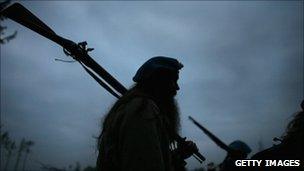Reservists to recreate Jacobite night march of 1746
- Published

Generations of people continue to be interested in Culloden and the Jacobites
The Territorial Army (TA) is preparing to retrace a possible route followed by Jacobite forces who were attempting to ambush a government camp in 1746.
The night march of 15 April, 265 years ago, was aborted short of its target on the outskirts of Nairn.
Bonnie Prince Charlie's forces were defeated at Culloden the next day.
In 2009, four people required hospital treatment to foot and leg injuries during the first "real-time" re-enactment of the march.
This will be only the second recreation to be held in the same time frame as the original march.
It has been planned by C Company, 51st Highland, 7th Battalion The Royal Regiment of Scotland, also known as 7 SCOTS.
Commandos of the Royal Marines Reserve and several members of re-enactment group, Battlescar, are expected to join about 30 TA soldiers on the trek.
A further 30 people drawn from the Army Cadet Force, Air Training Corps and Sea Cadets are also due to take part on stages of the latest recreation.
The march, which will not be open to the public, will be staged ahead of the 265th anniversary of the Battle of Culloden on 16 April.
The TA hopes to further understand the effects of 1746 night march on the Jacobites.
Research will include measuring and observing the affects of lack of sleep on judgement and the importance of food and provisions, or lack of them, for the soldiers on the march.
On 16 April, commemoration events at the battlefield will include a traditional service led by the Gaelic Society. A lone piper will also be present.
Visits to the National Trust for Scotland managed site are high with 124,053 visitors in 2008-09 - when a new visitor centre opened - and 112,565 in 2009-10.

2009 saw the first "real-time" re-enactment of the night march
Archaeologist and Culloden expert Dr Tony Pollard, from the University of Glasgow, took part in the 2009 night march.
He said the battlefield and its history continued to captivate the imagination of archaeologists as well as the wider public.
Dr Pollard said: "On an objective level, Culloden is a very interesting period of history.
"It came at the time of improved literacy and increased military bureaucracy meaning the battle is well recorded, however, we cannot take all these accounts at face value and there has to be a marrying of the archaeology with the records."
He added: "The investigations at Culloden are by no means over. Culloden is a flagship laboratory for battlefield archaeology and the new visitor centre has reinforced that.
"In terms of casualties it was a very small battle and the death toll pales when you consider other battles such as Pinkie, where tens of thousands were killed.
"Yet it still has that resonance and there is a romance related to it. Everyone loves an underdog and Culloden is an ultimate tale of that."